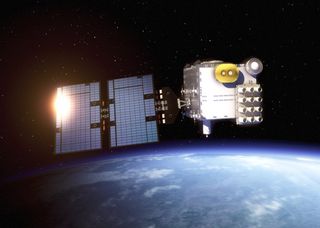This year's Atlantic hurricane season has been quiet to date, but meteorologists always know that could change — and soon they'll have a new tool for improving forecasts of how these severe storms will behave.
That tool is a mission called the Constellation Observing System for Meteorology, Ionosphere, and Climate-2, or COSMIC-2, a suite of six satellites being developed under the aegis of the National Oceanic and Atmospheric Administration (NOAA). The mission will launch on a SpaceX Falcon Heavy rocket on Monday (June 24) during a launch window that opens at 11:30 p.m. EDT (0330 June 25 GMT).
"It really allows us to enhance our predictive capabilities for hurricane systems," Elsayed Talaat, director of the Office of Projects, Planning and Analysis for NOAA's Satellite and Information Service, said during a media call. "We want to be able to forecast these systems more accurately to be able to better mitigate the severe impact that storms like Harvey, Maria, Irma, Florence and Michael have had on the U.S. in the past two years alone."
Related: Hurricane Florence in Photos: See the Massive Storm from Space

An artist's illustration of one of NOAA's COSMIC-2 satellites in orbit.
(Image credit: Surrey Satellite Technology Ltd.)
The six COSMIC-2 satellites are each about the size of a kitchen stove and cost NOAA a total of about $75 million, Talaat said. (The U.S. Air Force and Taiwan are partners on the project as well.) Once the satellites launch, the operations team will spend about seven months testing them before the mission officially becomes active.
But once it does, COSMIC-2 will offer meteorologists data about air temperature, pressure and humidity in the equatorial region of Earth — precisely where hurricanes and tropical storm systems form. The new mission will provide particularly detailed information about how those characteristics change at different altitudes.
To do so, the spacecraft will use a technique called radio occultation. The COSMIC-2 orbiters are tuned to pick up signals produced by GPS satellites. But the atmosphere distorts these signals as they travel toward Earth. COSMIC-2 orbits at a lower altitude than GPS satellites and can measure the signal distortion caused by the intervening atmosphere.
That data combined with measurements taken by a host of other weather satellites will help scientists understand what's going on in Earth's atmosphere. The six COSMIC-2 satellites all orbit the equator, offering a detailed look at atmospheric characteristics between 40 degrees north and south of the equator.
That's why the mission interests hurricane experts — tropical storms form in this region, feeding off the warm waters over the equator. Gathering better data about the moisture content of the atmosphere at different altitudes in this region will improve scientists' ability to vet and improve their models.
In the long run, the better the models are the better forecasts will be, which means that meteorologists hope the COSMIC-2 mission will help them spot burgeoning hurricanes earlier. The mission may also improve meteorologists' predictions of what direction storms will move in, although scientists need to see the satellites' data before they know how much of a boost the data will offer, Daryl Kleist, a physical scientist at NOAA's Environmental Modeling Center, said during a news call.
"While we can't escape the weather, if we know what's coming we can prepare for it," he said.
Visit Space.com on Monday (June 24) for complete coverage of the Falcon Heavy launch.
Email Meghan Bartels at mbartels@space.com or follow her @meghanbartels. Follow us on Twitter @Spacedotcom and on Facebook.
https://www.space.com/spacex-falcon-heavy-noaa-hurricane-forecasting-stp2.html
2019-06-21 11:41:00Z
52780317653107
Tidak ada komentar:
Posting Komentar